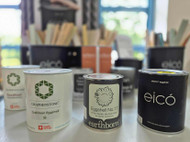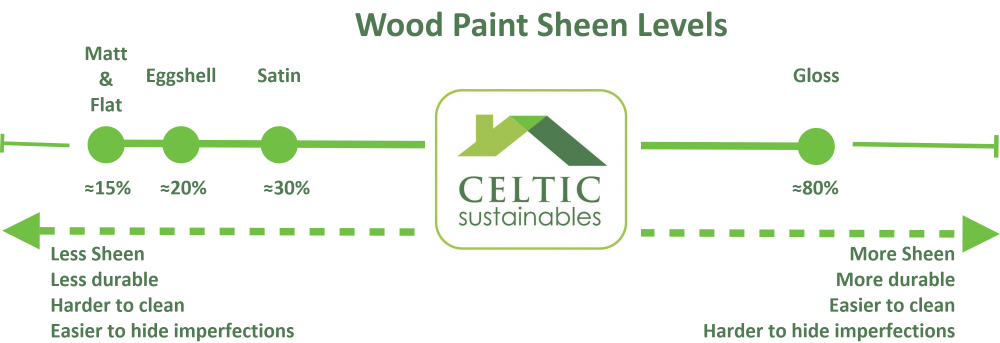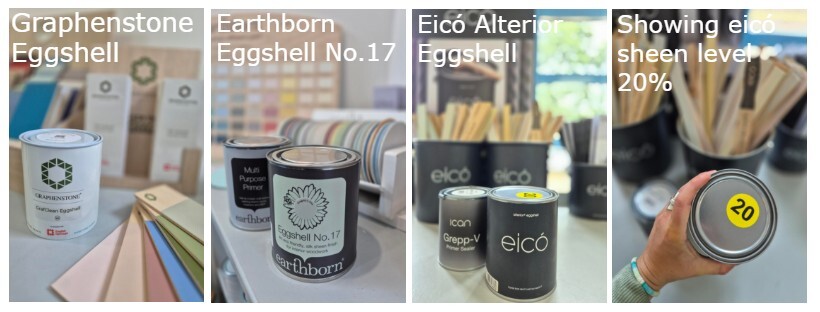The Difference between Gloss, Satin and Eggshell Paints from Celtic
Posted by Sarah, Celtic Sustainables on 3rd Oct 2025
Wood Paint Finishes Explained
Ever felt confused when walking into a paint shop for wood paint and seeing labels like "gloss paint," “Eggshell Paint," “Satin Paint," and "flat eggshell"? Oh, and I almost forgot silk paint! You're not alone; we’ve all been there. When I began working at Celtic Sustainables in 2017, I found the variety of paint finishes confusing. Through experience, learning from colleagues, and discussions with paint brands and customers, I have finally compiled this into a useful guide for you.
We’ll break down these terms to make them as simple as possible. There are four main types of paint finishes offered by all leading manufacturers: matt/flat, eggshell, satin and gloss.
The difference between gloss and satin: below, we discuss satin and gloss finishes for woodwork. Satin emulsion is generally a term that applies only to wall and ceiling paints!
There are key differences between the look and feel of the paints:
Sheen Levels: The journey through paint finishes begins with a soft, low sheen known as flat or matt eggshell, which offers a subtle 15% sheen. This finish, while visually appealing, ranks as the least durable option available. As we ascend the sheen scale, we encounter eggshell with its gentle 20% sheen that strikes a balance between durability and aesthetics. Next up is satin, boasting a refined 30% sheen that enhances its durability and is one of our most popular wood paints. And finally, full gloss, with an eye-catching 80% sheen, making it the ultimate choice for durability and a sleek, polished look.
Cost Considerations: In the world of paint, the relationship between sheen and cost is straightforward. The lesser the sheen, the more budget-friendly the option. Glossier paints tend to come with a higher price tag, a reflection of their complex formulation that includes more solid binders. This not only enhances their durability but also equips them with exceptional weather resistance and washability—qualities that make them ideal for high-traffic areas or exposure to the elements.
Durability Insight: A simple rule governs paint choices: increased sheen correlates with enhanced durability. This is why you’ll often find glossier finishes on external surfaces, as they stand up remarkably well against the elements. For interior spaces like living rooms and bedrooms, it’s wise to use flat or satin eggshell finishes for areas that experience low foot traffic. Personally, I’ve opted for matt eggshell on my windowsills in the bedroom and on the skirting boards, and after seven years, they continue to look great. I do get a little anxious when someone sets a cup down on the windowsill, but the Eico paint has proven its worth, maintaining a great finish. Alternatively, in busier areas of my home, I have chosen eggshell paints that offer a slightly higher sheen and improved durability.
Where to Use Eggshell Paint: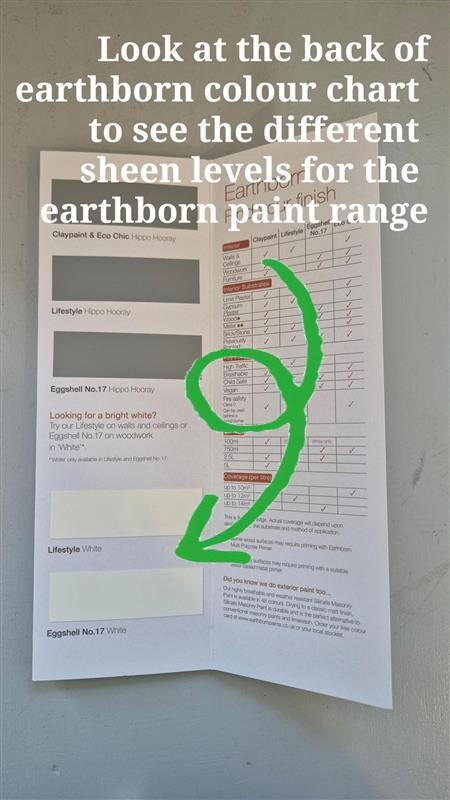
Eggshell paint is perfect for your doors, skirting boards, trims, furniture, and exterior timber like fences, sheds, benches, and more. Our eggshell options are designed to stay non-yellowing, durable, and have been tried and tested by the Celtic team right in our own homes. Feel free to chat with us if you’re curious about any specific finish or need a friendly recommendation!
No eggshells are used in the manufacture of eggshell paints! (It gets its name because the sheen is similar to that of the shell of an egg).
When applying eggshell paint to doors, you have two main options. You can use a brush for more control and detail, which is ideal for beginners. If you're aiming for a perfectly smooth finish, spraying the paint can give you professional-looking results. Just ensure you're prepared with the right equipment and proper technique for spraying.
Where Not to Use Eggshell Paint:
Eggshell paint isn't suitable for every environment. It isn’t typically used over gypsum plasters, because a satin finish isn’t a desirable look most people want. Take particular notice of what you paint on to; all our eggshell paints are water-based, and if you are overcoating an oil-based gloss, then you will have to sand back the surface, and you will need to use a primer.
Don't mistake high gloss eggshell paint for floor paint; use a product designed for floors, like Eico Alterior Floor Paint, which is 40% satin finish, low dirt pick-up, weather-resistant, and washable. Always use the recommended primer as an undercoat.
What is the Best Way to Apply Wood Paint: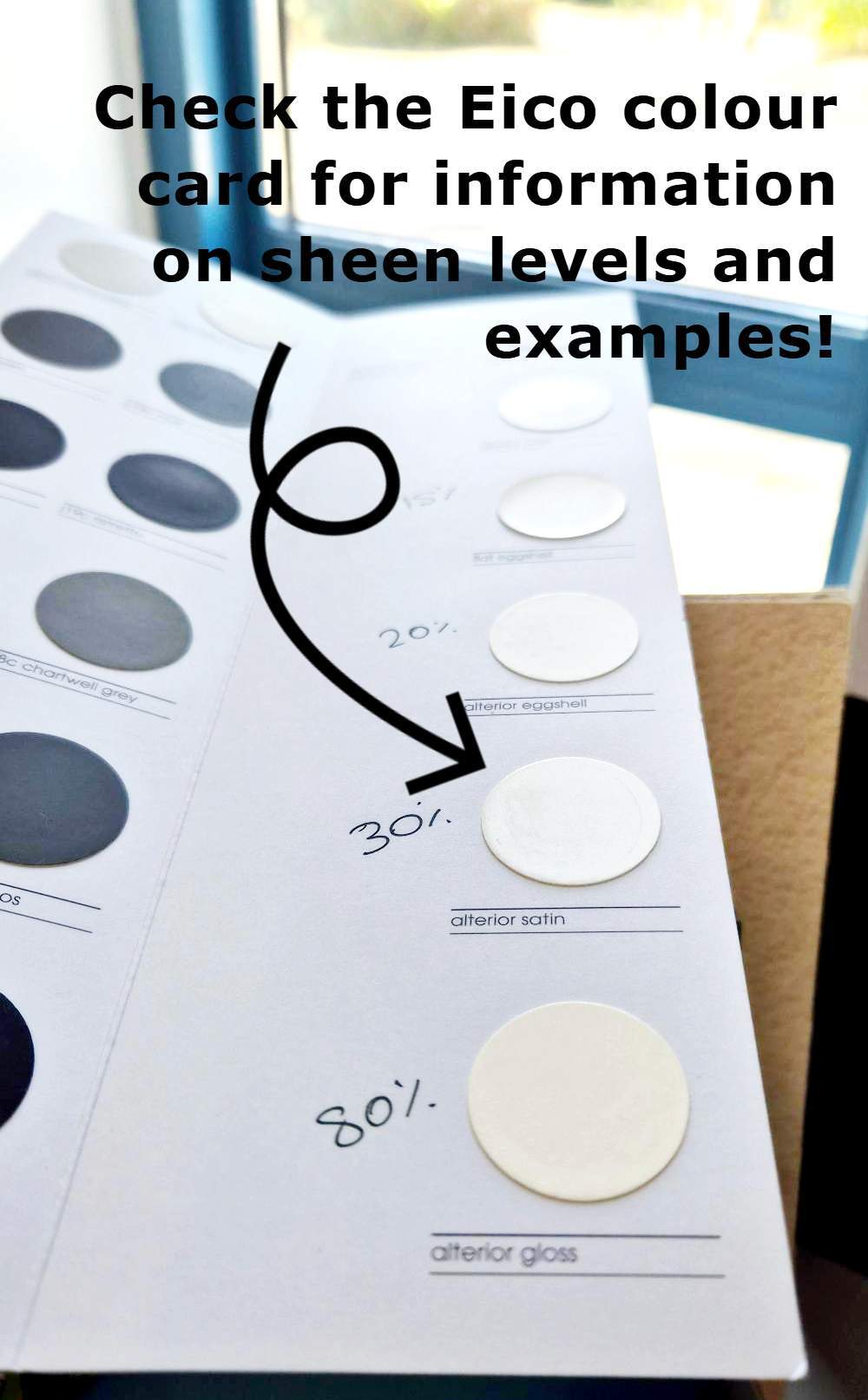
To achieve a flawless application of wood paint, begin with thorough preparation. First, sand the surface to create a key for the new paint to adhere to. Clean off dust and debris, then prime the wood to enhance the paint’s vibrancy and durability. When applying the paint, use a high-quality brush or roller to ensure even coverage. Start with long, smooth strokes, and remember to follow the wood grain for a seamless finish. For the best results, apply multiple thin coats rather than a single thick layer, allowing ample drying time between each application. This meticulous process will result in a stunning, professional-looking finish that showcases the wood's natural beauty. Do it properly, following the manufacturer’s guidelines and using the appropriate primer will ensure your woodwork continues to look its best. Do it properly – do it once, is what I say!
Remember to order some colour cards from our website. They clearly show the colours, and Earthborn and Eico include a swatch on the back fold that displays their paints' sheen level. This is very helpful for demonstrating how light reflects off the surface, which varies from emulsion matte paints.
Paint brands typically don’t provide samples in eggshell satin finish because these are small but costly products. Samples are meant to give a good sense of the colour, so choose one from emulsion ranges such as Graphenstone, Eico, or Earthborn. Pay attention to the shade—it’s usually slightly lighter in the eggshell finish compared to the emulsion (for walls) due to the satin eggshell finish, which reflects light differently than matt emulsion.


